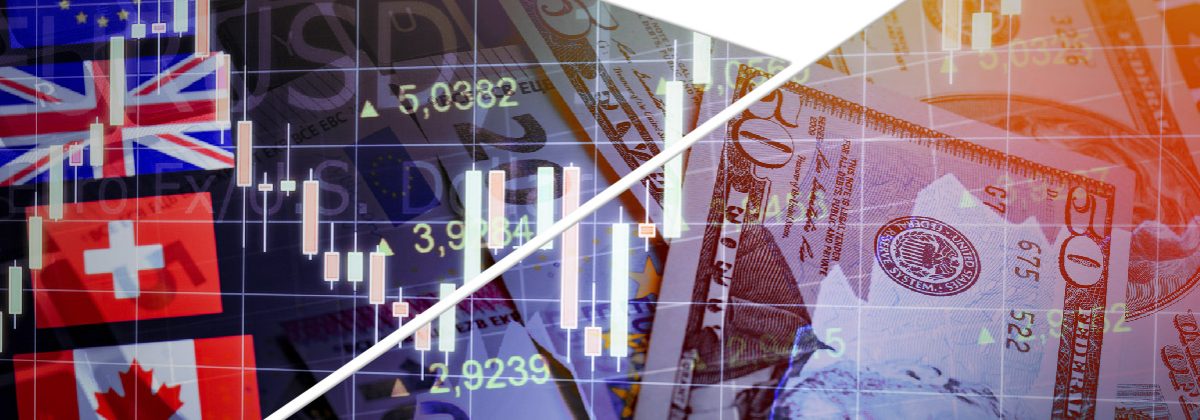How Will Fed’s Rate Cuts Impact Forex Trading?

The Federal Reserve’s (Fed) controls money supply in the US by adjusting interest rates in the country. Being the dominant global reserve currency, the value and supply of the greenback impact economies across the world. Nearly 80% of forex trade involves the US dollar, making it the most watched currency among forex traders. Since the beginning of 2024, there have been speculations of the Fed beginning its monetary loosening regime, cutting interest rates. This article dives into the after-effects of the Fed’s quantitative easing and what traders can expect from the FX markets.
How Fed Rate Cuts Impact the Forex Markets
As the Fed decreases interest rates, the US dollar’s demand declines. Here’s how this could impact other currencies:
EUR
Historical data shows that on average, the EUR declines 1% the year before the Fed pulls back rates and rises about 3% during following the year. As of the beginning of May 20224, the EUR/USD was down 1.86% over the last 12 months, indicating strong returns after the easing cycle begins.
GBP
GBP has registered 4 losses out of 7 times during the Fed’s easing cycle. Data from the 1980s to 2024 shows that the British pound has lost up to 13% of its value after the first rate cut. As of May 2024, the GBP/USD was down 0.73% from the May 2023 levels. The Bank of England (BoE) has hinted towards a June cut, due to a slack in the economy. However, a cut ahead of the Fed may further weaken the GBP.
JPY
The Japanese yen is negatively correlated with the greenback. However, after the Fed’s May 1, 2024, announcement of holding interest rates steady, the yen strengthened, even as the dollar grew. The primary cause of the surge was the Bank of Japan’s (BoJ) intervention, worth about $60 billion, to stimulate Japanese economic growth. Japan’s central bank may raise interest rates after June 2024, albeit gradually. The reducing gap between American and Japanese interest rates will determine the yen’s moves. Traders must keep a close eye on the policies of both banks to make informed decisions about this volatile currency pair. One thing that is for sure is that the volatility will generate ample opportunities for traders to optimise their earnings.
CNY
The Chinese yuan is unlikely to decline further, given the Chinese government’s persistent attempts to stabilise the currency against the dollar. With continued stimulus from policymakers, the USD/CNY exchange rate is expected to hover around 7.10. An interest rate cut by the Fed may reduce yield differentials between the American and Chinese economies. More importantly, the amount of dollars held in Chinese reserves is unknown, which gives a slight edge to Chinese policymakers to influence the movement of the currency.
Other Asian Currencies
The INR (Indian rupee) and KRW (South Korean won) may benefit from a cut in interest rates by the Fed. While the INR has declined 0.24% between November 2023 and May 2024, the KRW has lost 3.41%, due to the Fed’s “higher for longer” stance. Positive economic outlook for both economies in 2024 is expected to push their respective currencies higher against the dollar as the Fed rates are cut.
Is the Fed Ready to Cutback Interest Rates?
High interest rates for any currency attract foreign investments supporting the currency. High demand raises the currency’s value. Since the USD dominates global trade, a high US Dollar Index (USDX) translates into heightened commodities costs worldwide. As the USDX rises, traders tend to purchase USD in exchange for other currencies to earn profits. However, internally, high interest rates mean heightened borrowing costs, which reducing economic activity in the country, dragging inflation down.
Fed Is Not Dovish Yet; Only “Less” Hawkish
Soaring inflation after the pandemic pushed the Fed to raise key interest rates to cool down the economy. Since mid-2023, the world has been speculating on a rate cut. Fed Chair Jerome Powell, however, announced that the rates would be held steady at the current levels on May 1, 2024, stating that “inflation is still too high.” This was after the Consumer Price Index for Urban All Consumers (CPI-U) grew 0.4% (seasonally adjusted) over its February value in March 2024, and 3.5% (not seasonally adjusted) over the last 12 months. The resilience of the American economy has raised fears that a rate cut may fuel inflation back to the 2023 levels.
The November Elections May Be Delaying the Inevitable
With stubborn inflation, the January 2024 expectation of seven 0.25 bps rate cuts has gone down to only 3 such reductions. Analysts across several major banks, including the Bank of America (BoA) and Goldman Sachs, have already started weighing in on a slim chance of another rate hike. This is despite Powell’s dismissal of any such possibility. Also, the US central bank avoids dramatic interest rate changes right before the presidential election. Although there have been exceptions to that, like the one in 2004, those were part of the country’s then economic landscape. Forex traders must keep a close eye on the Fed’s next move as the scales may tip on either side.
To Sum Up
- The forex markets are extremely sensitive to central bank policies.
- Forex traders must closely observe inflation, employment, and GDP data to predict central banks’ moves and make informed trading decisions.
- The Fed’s rate decisions impact not just the USD but also other currencies, since the greenback is the world’s reserve currency.
- Persisting inflation has led the Fed to postpone rate cuts so far in 2024.
- Keeping an eye on the Fed’s next moves are important to bolster your forex trading strategy.
Disclaimer
All data, information, and materials are published and provided “as i” solely for informational purposes only and are not intended nor should be considered, in any way, as investment advice, recommendations, and/or suggestions for performing any actions with financial instruments. The information and opinions presented do not consider any individual’s investment objectives, financial situation, or needs, and hence do not constitute advice or a recommendation concerning any investment product. All investors should seek advice from certified financial advisors based on their unique situation before making any investment decisions by their personal risk appetite. Blackwell Global endeavors to ensure that the information provided is complete and correct, but makes no representation as to the actuality, accuracy, or completeness of the information. Information, data, and opinions may change without notice and Blackwell Global is not obliged to update on the changes. The opinions and views expressed are solely those of the authors and analysts and do not necessarily represent those of Blackwell Global or its management, shareholders, and affiliates. Any projections or views of the market provided may not prove to be accurate. Past performance is not necessarily indicative of future performance. Blackwell Global assumes no liability for any loss arising directly or indirectly from the use of or reliance on such information herein contained. Reproduction of this information, in whole or in part, is not permitted.




